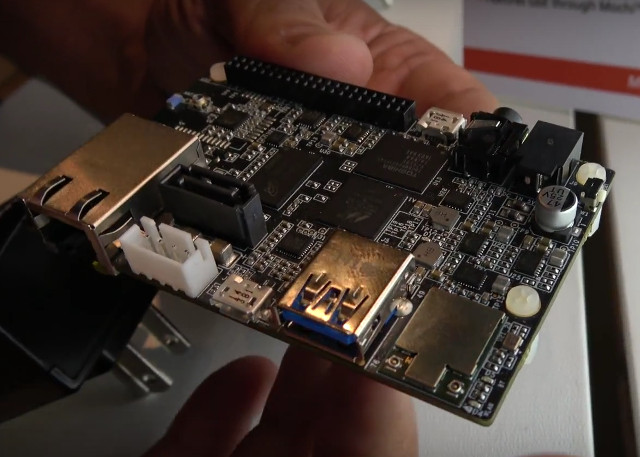Last year, Marvell introduced AndroMeda Box Edge IoT board using 96Boards form factor and running Brillo (now Android Things), but the company has been working on the similarly named AndromedaBox Networking Edge (ANE) board with a tweaked version of 96Boards form factor including Gigabit Ethernet and SATA, and powered by a dual core ARMADA 3700 processor.
AndromedaBox Networking Edge specifications:
- SoC – Marvell ARMADA LP 3700 dual-core ARM Cortex 53 processor @ up to 1.2 GHz
- System Memory – 512MB LPDDR4
- Storage – 8GB eMMC flash, 1x SATA 3.0 port
- Connectivity – 1x Gigabit Ethernet RJ45 port, 1×1 802.11ac Wi-Fi, and Bluetooth 4.2
- USB – 2x micro USB 2.0 port, 1x USB 3.0 port
- Expansion – 1x PCIe 2.0 (maybe via a slot on the back of the board), 40-pin LS (Low Speed) Expansion connector
- Power Supply – Likely 8 to 18V input as per 96Boards specs
- Dimensions – 85 x 54 mm (Same as 96Boards CE Edition)
The board would be suitable for IoT gateways, mobile NAS, home cloud server, etc… You can watch a short description of the board in the video below.

Marvell ARMADA 3700 is the same processor as used in the company’s ESPRESSOBin community board, which means we already have a Wiki with a little more technical details (no processor datasheet though), as well as u-boot and Linux images and source code.
What’s odd is that there’s no trace of AndromedaBox Networking Edge board anywhere in the net, including in Andromedabox.org website, and the board via apparently introduced last June.
Via ARMDevices.net

Jean-Luc started CNX Software in 2010 as a part-time endeavor, before quitting his job as a software engineering manager, and starting to write daily news, and reviews full time later in 2011.
Support CNX Software! Donate via cryptocurrencies, become a Patron on Patreon, or purchase goods on Amazon or Aliexpress. We also use affiliate links in articles to earn commissions if you make a purchase after clicking on those links.





why can’t they just put at least 1GB of RAM on that thing. If it had 1GB of RAM and SATA port-multiplier support, then take my money.
512MB is good for me. Running ubuntu headless 15.04 on orange pi plus for about one year. Own cloud, plex, web, trans, and other… It is taking 265MB of ram.
@pucvoler
I agree, there’s not that much difference between 512MB or 1GB since the usual tasks on such a headless box aren’t that demanding and RAM will be used as usual: mostly filesystem cache/buffer.
On the other hand we’re talking about ARMv8 here, rather fast CPU cores and 4.4 LTS kernel support. So we could use virtualization here but we can’t since with just 512 MB DRAM it’s kinda useless. On a so called ‘Edge board’ I want to shove all the stuff exposed to the edges into a somewhat separated environment and not running directly on the same host where internal data will be processed (what’s the SATA port for?!) so providing a version with optional 2 GB would make some sense (AFAIK 2 GB are the maximum with Armada 3700).
But why bother since ESPRESSOBin is real, can be ordered with 2 GB DRAM, contains power circuitry to provide a 3.5″ disk, comes with 2 more GbE ports (all behind an internal switch that is connected to the SoC with 2.5GbE so no artificial bottleneck here) and where 2 more real SATA ports can be added with a cheap mPCIe ASM1062 card.